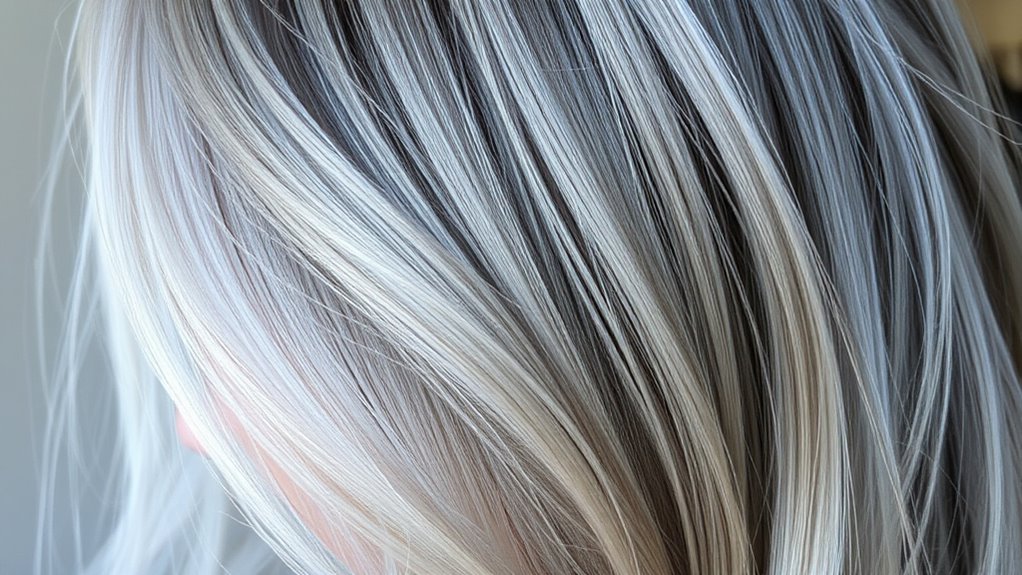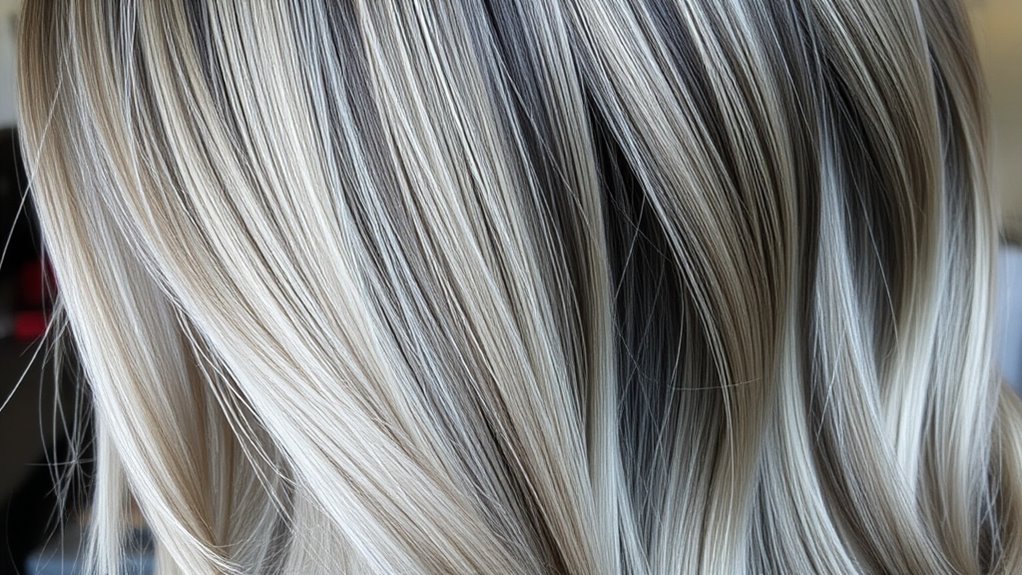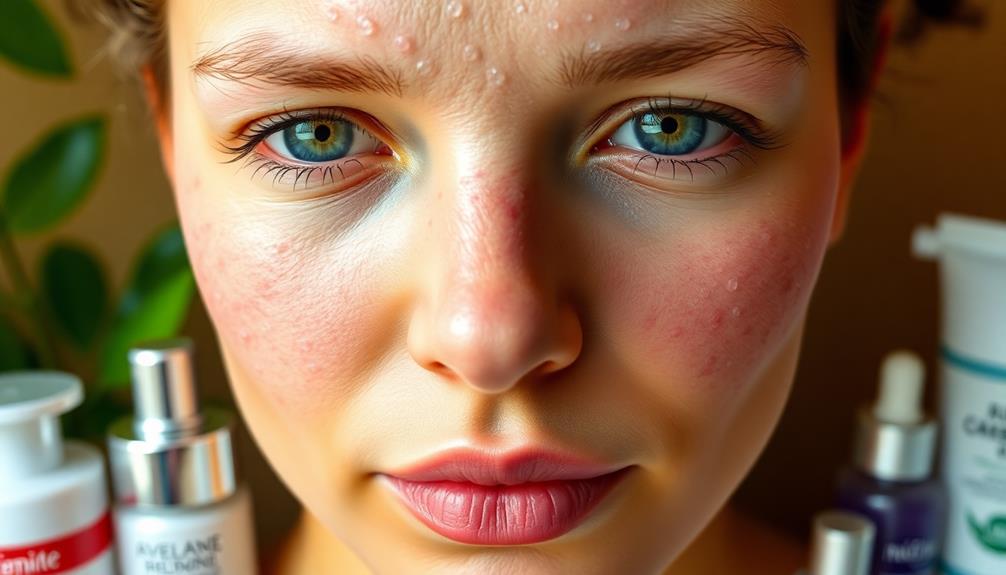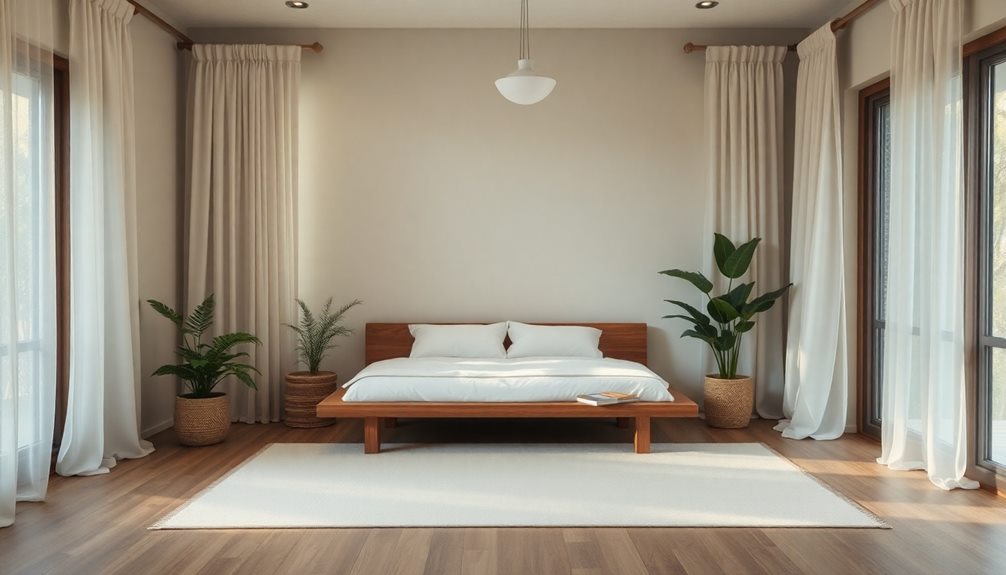To soften the grow-out and maintain dimension, blend gray carefully into your natural or desired shades using feathering techniques with foils, balayage brushes, or sponges. Focus on subtle color gradations, adding layers gradually to create a seamless, organic look. Avoid over-blending to preserve depth and contrast, which keeps your hair vibrant and lively. Patience and precise application are key—continue exploring methods for a flawless, effortless finish.
Key Takeaways
- Use intermediate shades to create seamless transitions between gray roots and colored ends.
- Apply blending techniques like feathering with foils or balayage brushes for soft, organic results.
- Focus on layering small amounts of color to maintain dimension and prevent flatness.
- Regularly check progress and adjust to preserve contrast and natural highlights.
- Patience and precise application help achieve a natural, multidimensional finish while minimizing grow-out visibility.

Gray blending is an essential technique in art and design that helps create smooth progressions and realistic shading. When it comes to hair, mastering this technique allows you to achieve a seamless hair color transition, especially when working with gray blends. Whether you’re a stylist or a DIY enthusiast, understanding how to use blending techniques effectively can make the difference between a harsh grow-out and a soft, natural finish. The key is to carefully shift colors so that the hair appears multidimensional and natural, rather than stark or patchy.
Gray blending creates natural, seamless hair transitions for a softer, more dimensional look.
To start, you need to choose the right shades that will help you blend gray into your natural hair color or other hues. This involves selecting intermediate tones that serve as a bridge between the darker roots and the lighter ends or gray patches. Using a gradual approach, you apply color in small, controlled sections, blending each layer into the next. This technique minimizes visible lines and creates a gentle, gradual shift, making the grow-out less noticeable over time. The transition should mimic natural hair growth patterns, so your goal is to soften the line of demarcation and integrate the gray smoothly into the surrounding color.
When applying blending techniques for a hair color transition, focus on the roots and the areas where the gray appears most prominent. Work with a light hand, using tools like foils, balayage brushes, or sponges to feather the product into the hair. This feathering creates a diffused effect that mimics natural highlights and lowlights, giving your hair a more organic look. Remember, the goal isn’t to cover the gray entirely but to blend it into the rest of your hair for a more harmonious appearance. It’s often helpful to work gradually, layering small amounts of color and checking your progress frequently.
Another important aspect is maintaining the dimension of your hair. Over-blending can make your hair look flat or dull, so you want to preserve some contrast to add depth. You can achieve this by selectively blending certain sections more than others, emphasizing the natural variation within your hair. Regular toning can also help maintain the desired shades and prevent the gray from becoming too harsh or stark. Proper blending techniques and attention to detail will ensure your hair remains vibrant, natural, and full of dimension, even as it grows out.
In essence, mastering gray blending with effective blending techniques allows you to create a beautifully seamless hair color transition. It’s about carefully balancing the shades, softening the grow-out line, and preserving your hair’s natural dimension. With patience and precision, you can enjoy a polished look that ages gracefully and makes your color appear effortless and natural. Additionally, exploring hackathons can inspire new creative approaches and innovative solutions for hair coloring techniques.
Frequently Asked Questions
How Often Should I Touch up My Gray Blending?
You should do root touch ups every 4 to 6 weeks to maintain your gray blending. This helps keep your color fresh and seamlessly blended as your hair grows out. If you notice dullness or unevenness, consider a quick color refresh. Regular touch ups prevent harsh lines, ensuring your hair stays natural and vibrant. Adjust the frequency based on your growth rate and desired look, but don’t wait too long to keep it looking flawless.
Can Gray Blending Be Combined With Highlights?
Yes, you can combine gray blending with highlights to create stunning color contrast. Adding highlights enhances dimension and seamlessly integrates gray hair, making it look more natural. If you use hair extensions, you can incorporate highlights or blended shades to match your overall color. This approach keeps your look fresh and dynamic while effectively softening the grow-out, giving you a vibrant, youthful appearance.
Is Gray Blending Suitable for All Hair Textures?
You might worry gray blending isn’t for your hair type, but it can be suitable for all textures. If you have high hair porosity or scalp sensitivity, a skilled stylist adjusts techniques to minimize damage and discomfort. Gray blending works by seamlessly integrating gray with your natural color, creating a soft, natural look. So, no matter your hair texture, you can achieve beautiful, age-defying results with the right approach.
What Products Are Best for Maintaining Gray Blended Hair?
For maintaining gray blended hair, you want products that enhance your gray tones and keep your hair healthy. Look for sulfate-free shampoos designed for color preservation and grey hair, like purple shampoos that neutralize brassiness. Incorporate conditioners with nourishing ingredients and use styling products with UV protection. These gray blending techniques combined with the right product recommendations help keep your hair vibrant, soft, and well-maintained while preserving your natural dimension.
How Long Does a Typical Gray Blending Treatment Last?
Your gray blending treatment typically lasts about 4 to 6 weeks, but it really depends on your hair type and maintenance routine. Think of it as comparing different techniques—some provide longer-lasting color than others. To make it last longer, use color-safe shampoos and touch up as needed. Regular visits can help maintain the seamless blend and keep your hair looking vibrant, so you’re always ready to shine.
Conclusion
Now that you know the secrets of gray blending, you’re ready to soften your grow-out and keep your dimension alive. Think of it as a gentle sunrise—gradually revealing new hues while maintaining the beauty of your existing color. With these techniques, you’ll turn what could be a dull progression into a stunning masterpiece. Embrace the blend, and watch your hair transform into a work of art that flows seamlessly from root to tip.










